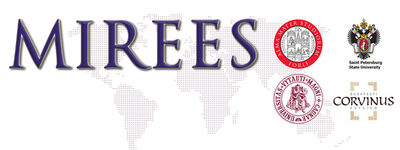and Balkan Europe
by IECOB & AIS Università di Bologna

Remembering and reconciliation processes in Central European Region. Case of Slovak - Hungarian Relations
MIREES’ Open Lecture

Written by Marta Bollito, BA
MIREES’ student, University of Bologna, Forlì-Campus
On December 7th 2015, professor Michal Vasecka from the University of Brno lectured to the MIREES students on the difficult case of Slovak-Hungarian reconciliation. These two countries share a long history of violence and ethnic despise, that is particularly felt in those areas that are closer to the border. An image of unacceptance and nationalistic pride is too often reflected not only in the mass media, but in folk literature and history textbooks.
Professor Vasecka started by giving a couple of different (and sometimes funny) definitions used to describe the concept of Central Europe: he explained the concept of Mitteleuropa, that of Zwischeneuropa and subsequently added that, according to the Czechoslovak writer Kundera, for example, Central Europe is “that part of Europe that smells like beer and watermelon and where the metro stations all look alike”. Another typical trait of Central Europe, added Vasecka with the same playful tone, is the everlasting presence of the apple strudel.
He then proceeded on giving different interpretations of the concept of reconciliation, which has in time been defined as the reestablishment of friendly relations (for example in the case of the Franco-German relations), as a sacrament of the Catholic tradition more commonly known as the sacrament of confession, an action that brings about peace and harmony, ending the strife, and, in a more general and precise way, the development in which political, economic, and societal reforms lead to the transformation of a society emerging from a conflict into one at peace with itself, its various ethnicities and minorities , as well as its neighbors.
In the particular case of the relations between Slovakia and Hungary, several measures of reconciliation were adopted and implemented: a number of commissions were established in both countries for the search of truth and reconciliation, and for the creation of fair and just history and school textbooks. Also, several programs were created in order to promote exchange among young people, so as to ease mutual understanding and acceptance, and also civil society enhancement. Moreover, formal and non-formal reconciliatory policies were put into practice by both countries, taking into particular consideration the civil rights of the minorities living on a country’s territory.
The factors that have been hindering and slowing down the process of reconciliation between these two Central European countries, according to professor Vasecka, are to be found in the lack of internal reflection on history, in the dominance of nationalist narratives and non-pluralist mass media, in internal and external controversies on economic, political and historical issues. In addition to that, there are several structural reasons for non-reconciliation in Central Europe – countries are unable to change their ethnicized character and move towards a post-nationalist era; the definition of the “core” part of the society calls for failure of the minority policies; different cases of historical and specific amnesia are present in every single country, and the misuse of the education system aiming at orienting the children towards mutual acceptance.
The lesson of professor Vasecka has been particularly interesting to attend because he managed to keep the interests of the students high by breaking down long and serious explanations about the historical moments that caused conflicts between these two nations, with interesting notions about the similarities and differences among these people. For example, he explained that in Slovak language, the saying “Čo si, maďar?” which literally means “What are you, Hungarian?”, but that actually is used to say “what are you, stupid?” is still quite common, although people now realize the political incorrectness of it. (Interestingly enough, I recently found out, studying Slovak, that there is another version of this, that says “What are you, Italian?”). The same saying, apparently, exists in Hungary as well, but the word Hungarian is, clearly, substituted with “Slovak”.
The seminar was an interesting one, shedding light on a difficult side of the Visegrad countries that would otherwise be easily forgotten by those simply studying it and not living its reality to a full extent.
PECOB: Portal on Central Eastern and Balkan Europe - University of Bologna - 1, S. Giovanni Bosco - Faenza - Italy
Chiudi la versione stampabile della pagina e ritorna al sito.
 Download "Remembering and reconciliation processes in Central European Region. Case of Slovak - Hungarian Relations"
Download "Remembering and reconciliation processes in Central European Region. Case of Slovak - Hungarian Relations"